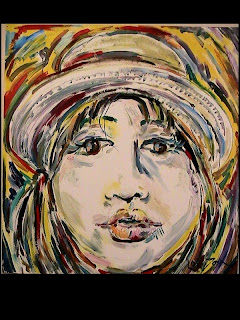By Ross Allen
 |
| "Abraham's Anguish" - A man succumbed by anguish. |
From various times, movements and styles, painters have been immortalized through their transference of the passion they feel in their lives; The pain and anguish of Van Gogh's psychosis bleeds onto the canvas, forming bright and heavy color swirls of movement and life, giving the viewer the power and passion (and perhaps even joy) required to appreciate his "Wheat Field with Crows." With "Empathicism," creator LORD TOPH imbues traces of his predecessors through visceral depictions of emotion that lays claim to a new style, by paying attention to the styles before it.
Style is usually depicted with a tangibly evident formula.
Much like a martial art, there is movement, formation, philosophy,
execution, and even an expected range of outcome. Empathicism began with
the combination of various styles (expressionism, impressionism, abstraction,
to name a few), culminating in each style supporting the framework in the
philosophy of its visual empathy; to convey specific emotions to the viewer,
every time. As we all feel the same emotions, the same emotion can affect
each person differently. Empathicism allows for the potency of other
styles to reflect visual emotion, as multiple feelings can be experienced from
one depicted emotion, as well as its inherited styles.
Take for instance LORD TOPH's painting, "Abraham's
Anguish," the first painting of the "Expressions of Empathy"
series, and the first painting of Empathicism. This painting portrays a
man named Abraham (no direct connection to the biblical Abraham) who is
personified by his own tormenting anguish. Monochromatic colors of blue,
purple and green swirl and surround Abraham, whose face encompasses almost the
entire painting. Before I get any more descriptive into the underlying
context and the all out formula of the painting (and I can) it is most
important for me to accredit this work to another poignant piece in artistic
foundation; Edvard Munch's "The Scream."
Edvard Munch's creation of "The Scream" came from
his evening walk on a bridge overlooking Oslofjord, Norway. According to
Munch himself, he was walking with his friends, when he stopped to witness what
he heard was "Nature's Scream.". The now painting shows the blood red
sunset covering the skyline, depicting the bloodshed of nature and the ominous
figure (perhaps a personification of Munch himself or Nature) in complete and
utter fear and agony - a tell-tale sign of Empathicism indeed.
LORD TOPH's "Abraham's Anguish" was not directly
influenced by "The Scream." Yet, like Munch, LORD TOPH concentrates
on various styles, influences and emotion to convey a specific emotion that
encompasses both the painting and the viewer. Both paintings carry an
abstraction in execution to exemplify the potency of emotion. Both
paintings show the subject in distress and anguish, giving a human perspective
that directly connects us with the paining. Both paintings also use a
color application that psychologically articulates the mood and tone of their
worlds. So why would "Abraham's Anguish" not simply be a form
of Expressionist painting, such as Munch's "The Scream?"
Keep in mind, Munch didn't initially create "The
Scream" as a precursor or even a starting point for Expressionism.
He was a powerful enough painter and individual to portray life devoid of
the lines and boundaries that we use to describe it. Through the power of
emotion, color, and human relation, a foundation for artistic connection was
born, separated from reality. LORD TOPH's founding of Empathicism creates
artistic freedom specified by emotion and communicative direction. If you
see aspects of Expressionism, impressionism, Kandinsky, Klimt, or even Munch, any
and all aspects serve to tell the underlying story of emotion. It may be
the "Style of no Style" philosophy, of simply LORD TOPH's unconscious
deliberation of the masters before him.
And if so, I don't think they would mind - what would be the
point of their legacy, if they did?




